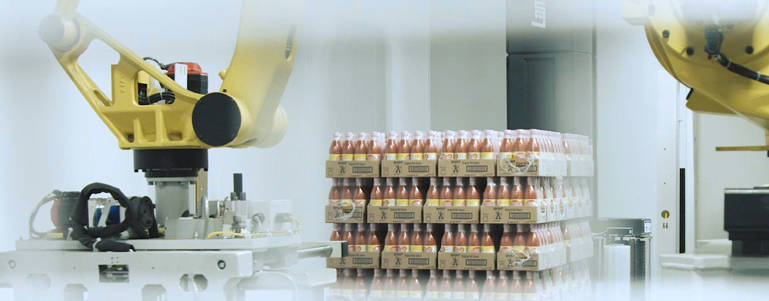Case Study - Doubles Production Capacity Without Additional Space

COMPANY PROFILE
Headquartered in Winston-Salem, North Carolina, TW Garner Food Company is famous for its Texas Pete® Hot Sauce, the #3 brand of hot sauce in the United States. Founded in 1929 as a maker of barbecue sauce, the company now sells a full line of hot sauces, wing sauces, and seafood sauce under the Texas Pete® brand, as well as CHA! by Texas Pete® sriracha sauce, and salsa and tortilla strips under the Green Mountain Gringo® brand. TW products are sold in supermarkets, military commissaries, convenience stores, and restaurants throughout the United States. The company is now in its fourth generation of family ownership.
REDESIGNING A BOTTLE ISN’T SO SIMPLE
TW Garner has always been open to feedback from their customers. One improvement that had been on their radar for some time was to enlarge the opening on all bottle sizes (6 oz., 12 oz., 32 oz.) to a 28mm opening so the product flowed out faster, something their customers in the culinary industry had been requesting for a while.
This format change, though, required new equipment. TW Garner had just expanded outside their current facility for storage and distribution, so they were not keen on requiring more space for new equipment. At the same time, they wanted to expand their capacity: fill more bottles but not require extra space. Eddie Martin, Controls Engineer and Automation Specialist at TW Garner, also desired increased automation, because the company had reached their automation threshold.
That list of challenges was already tough to overcome, but there was one more: TW Garner didn’t have the new bottles yet, a requirement for designing new production line equipment.
“That is not the way you want to do a project,” Gerald Lambert, Executive VP for Operations, says.
NO BOTTLES? NO PROBLEM
The Project Manager for Premier Tech took this all in stride, so much so, in fact, that Lambert didn’t feel like he was shouldering the entire project himself.
Despite the lack of a physical product (the bottles didn’t arrive until two or three months into the development phase), Premier Tech used drawings and concepts TW Garner had provided to design the equipment.
As a starting point, one robot palletizer was installed on a small packaging line. “That went over really well,” says Lambert, “with minimal issues. The technology was easy to work with.”After the success of the first robot, TW Garner installed four more on a different line: two robotic depalletizers, one robotic tray packer, and one robotic case palletizer.
SUPERB INSTALLATION AND CUSTOMER SUPPORT
Moving to robotics and installing five robots is not easy. The process therefore relies heavily on feedback from the customer, and Premier Tech knew how to listen to that feedback and answer the TW Garner team’s questions, resulting in lines that worked to TW Garner’s expectations.
Because manufacturing is an eclectic process, with many players involved, problems do appear, so all companies need to work well together. Lambert says Premier Tech never blamed the glass manufacturer, or said it was the cardboard causing a problem in tray packing, or that shrink bundling of palletizing was the problem: They simply fixed the issue.
“If there was going to be an issue with the equipment, or an issue with the rate, or any issues at all, I would have Premier Tech on top of it and not have to worry about them resolving the problem,” says Lambert.
But it wasn’t just during the project that Premier Tech helped TW Garner solve problems; it was also afterwards.
“Premier Tech’s customer care is really a great service,” Lambert says. “That particular part of their business is unique. I can’t say that I have that aspect with any of the other equipment that’s part of my line.”
Martin agrees: “As soon as you get someone on the line, they’re very patient. They’re very helpful, and the follow-up is incredible, because normally, you don’t get that from a company.”
“I’m not a programmer,” Lambert says. “I just know how to work my way through issues when they come up. When there is an issue I can’t resolve, I know that I’ve got customer care that I can rely on that will help me through those.”
THE FINAL PICTURE: FROM 1 ROBOT TO 5
In the end, five robots were installed. Not only could TW Garner use the same amount of space for the new equipment as they had for the old, they could double the capacity of their flagship product, the 12 oz. bottle, to 150,000 bottles per day. In addition, they can now fill up to 250,000 6 oz. bottles a day.
Lambert was also very happy with the robotic design. He called the end effector design “the best of the best.” In addition, he praised the ease with which TW Garner could now change patterns: With robot technology, they’re able to change end effectors quickly and efficiently, move lane arrangements for pick-and-place, and easily adjust depalletizing between different bottle sizes.
“You’re just changing a recipe,” Lambert says. “It made changeover and transition from product to product much easier and much more efficient.”
Lambert says that the standard benchmark for achieving a return on investment is two to three years, and they saw that ROI in two. The improved lines were more efficient and also allowed TW Garner Foods to realize more savings by changing from one type of packout to another. The final point Lambert wanted to make was this: Premier Tech stayed with the project the entire way through, even after the sale was long completed. They continued to offer their exceptional customer service whenever TW Garner called, solving problems and providing information whenever either was needed.
“There were intangible benefits that were revealed after the fact from the initial point of sale,” Lambert says.“I would recommend Premier Tech to anybody that is interested in investing and growing in robot technology.”